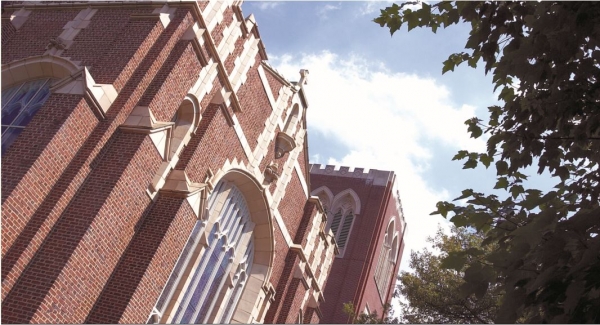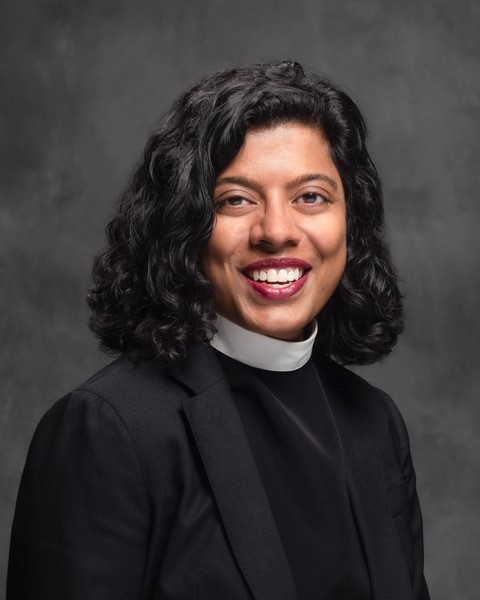Our History

St. Luke’s story is one of vision, rebirth and service. The church was founded in the 19th century as a refuge for those fleeing the ravages of war. Almost a century later, the "little refugee church" made an intentional decision to remain in downtown Atlanta as other churches were heading for the suburbs. These two "births" are vital to the DNA of the community that continues to worship and serve in Atlanta to this day.
Our history begins with Dr. Quintard. Dr. Charles Todd Quintard was born and raised in Connecticut and earned his medical degree in New York. He then moved south, and while a professor in the Medical College in Memphis became friends with the first bishop of Tennessee. Deciding to leave medicine, he studied for holy orders and was ordained a priest in 1856. When the Civil War broke out Dr. Quintard accepted a post as Chaplain of the Army of Tennessee although he had originally been a unionist. In 1863 the Army of Tennessee began a defensive struggle against Union forces and eventually retreated to Atlanta, bringing Dr. Quintard with it.
As the Civil War raged around it, Atlanta had a growing refugee population. Dr. Quintard decided a second Episcopal church was desirable, and with zeal in 1864 oversaw the building of the first St. Luke’s, a wooden structure with a school house appearance. It was consecrated by Bishop Stephen Elliott April 22,1864, at Broad and Walton Streets. Only four months later it was heavily damaged by Union artillery shelling and later that year was totally destroyed during the burning of Atlanta.
Dr. Quintard became the second bishop of Tennessee soon after the Civil War. As such, he spurred reconciliation between the northern and southern factions of the church. He was known as an opponent of racism and classism. While bishop, he also served for several years as head of the University of the South at Sewanee.
In 1870 the parish was reestablished as St. Stephen’s. On January 8, 1872, the vestry approved a motion made by Dr. John Milton Johnson “that the present name of our parish be changed to that formerly established – St. Luke's. Dr. Johnson had been confirmed in the 1864 St. Luke’s and then served as senior warden for the reestablished parish. The second church building in 1875 was at the corner of Spring and Walton Streets. Financial challenges ensued, and in 1880 Bishop Beckwith accepted St. Luke’s’ offer to become his cathedral church, feeling that would help strengthen the parish. A new cathedral building was erected at the corner of Pryor and Houston Streets. In 1894 the church returned to regular parish status. During this period when financial challenges were ongoing, faithful leadership from the vestry and clergy were notable. One senior warden, Z. D. Harrison, served a total of 37 years!
As the city grew and parish members moved northward, the vestry in 1904 sold the third church building in 1904 for $40,000 and secured a lot on Peachtree Street for $18,000. P. Thornton Marye, a parish member and architect of such landmarks as the Fox Theatre and Terminal Station, created the modified late English Gothic building in which we have worshipped since its consecration in 1906.
The stained glass windows were designed from a master plan and installed over a 60 year period. They are the work of Franz Mayer and Co. of Germany, known for its red and rich purple hues; Heaton, Butler and Bayne Co. of England, known for its subtle green glows, and Willet Stained Glass Co. of Philadelphia, known for its predominantly blue tones. The windows reflect events in the life of Christ from Nativity to Ascension. The smaller aisle windows below each larger one tell an Old Testament story complimentary to the life of Christ event above it. The Ascension Window next to the pulpit was moved from the 3rd church location when the current building was erected. Also moved was a smaller window, called Chorus of Cherubim, now located in the Bell Tower corridor.
The mural above the altar, known as “Christ as the Good Shepherd,” was created by noted muralist Edwin Howland Blashfield and installed in 1913. The effort to fill the blank space over the altar began with Helen Turman, who was referred to Blashfield and traveled to New York to meet with him. He at first declined, but later was persuaded to accept the commission for $5,000, a bargain price. The women of the church raised the money. The mural is considered still to be important as a fine work of art and a symbol of the visual arts in early twentieth century Atlanta.
Dr. Cary B. Wilmer served as rector from 1900 to 1924, the longest tenure of any rector to date. It was under his leadership that St. Luke’s began to earn its reputation for being a voice in Atlanta for moral and social justice.
Additions to the campus over the years have been made to accommodate church growth. The first was in 1924 and another in 1959. A green space of some 4 acres south of the church constituting “The Park at St. Luke’s” was created in the late 1980s in a joint venture with the Georgia Dept. of Transportation. A memorial garden was also created on the north side of the church. A $10 million renovation of the sanctuary was completed in 1999. A new bell tower was dedicated in 2000, which includes 10 change ringing bells. A columbarium is in the lower level of the bell tower.
The Alston Memorial Organ was installed in 1963. It has been modified and expanded since, and contains about 5,000 pipes. The music ministry has a long and influential history in the city. Organists from around the world have played and performed concerts from the organ. The church has a history of talented organists/choirmasters and choristers. The longest serving was Dr. Hugh Hodgson, 1929-1969, who was also the chair of the Department of Music at the University of Georgia.
St. Luke’s is committed to serve as a beacon of outreach and social justice in downtown Atlanta and beyond. It is known as a place which encourages members to live out their baptismal covenant through a variety of outreach ministries. In 1949 the Atlanta Cerebral Palsy School was begun in the Parish House by parishioner Anne Lane and her friend Rebecca Frazer. It is now The Frazer Center, located in the Cator Woolford Gardens on Ponce de Leon Ave. A soup kitchen begun in 1973 has grown to include daily meals, a job assistance program, health referral services, and a mailroom. Known now as Crossroads Community Ministries, it operates from the church campus. Bill Bolling started the Atlanta Community Food Bank in the church basement in 1979. Currently it distributes food to the needy through a network across the country with an independent annual budget in excess of $40 million. The Training and Counseling Center provides pastoral training and mental health services to the community and operates from the historic Edward Gay home on the campus, with several satellite locations around town. The church provides space and support for the Boyce L. Ansley School, providing a formal school atmosphere for children experiencing homelessness. It is named for a long-time parishioner who shared its vision, and is managed by parishioners and others through an independent board.
With about 2,000 members, St. Luke’s sees itself as a dynamic community of faith, striving to live out the Gospel in the heart of Atlanta.
--this history prepared by the Archives Committee in 2019
 Rector
Rector
 Director of Music
Director of Music